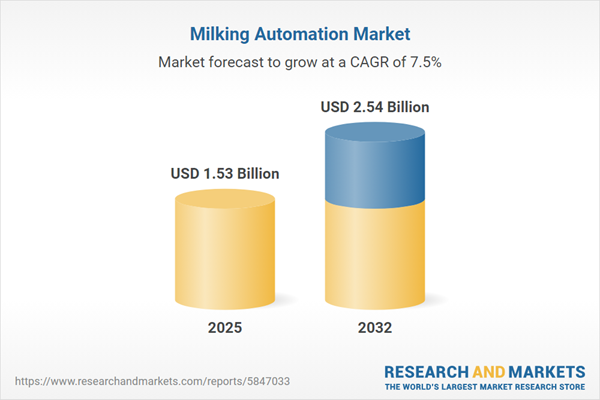Speak directly to the analyst to clarify any post sales queries you may have.
The milking automation market is experiencing transformative change as dairy operations worldwide adopt advanced technologies for efficiency, animal welfare, and sustainable production. Senior decision-makers evaluating future-ready strategies should recognize the sector’s accelerating integration of robotics, connectivity, and data-driven insights.
Milking Automation Market Snapshot
The Milking Automation Market grew from USD 1.42 billion in 2024 to USD 1.53 billion in 2025 and is projected to reach USD 2.54 billion by 2032, advancing at a CAGR of 7.54%.
This rapid expansion reflects the increasing urgency among dairy producers to enhance operational scale, address labor shortages, and comply with evolving regulatory demands. Automation enables continuous milking operations, drives consistent output quality, and supports transparent, traceable supply chains favored in global food markets.Scope & Segmentation
- System Types: Automatic milking systems, conventional milking machines, and robotic milking systems address operational needs across both smallholders and commercial herds.
- Component Categories: Hardware—such as controllers, milk meters, pulsators, sensors (conductivity, flow, temperature), teat cups, and vacuum pumps—works in tandem with software platforms like data analytics engines and farm management applications.
- Technology Layers: Artificial intelligence, data analytics, Internet of Things (IoT), machine vision, and sensor technology contribute to predictive health management and process optimization.
- Applications: Commercial dairy farms leverage full-scope automation, while cooperative and smallholder farms deploy modular and semi-automated solutions to maximize resource allocation.
- Farm Sizes: Solutions support large herds seeking productivity gains, medium herds balancing investment and complexity, as well as small operations requiring scalable entry-level tech.
- Distribution Channels: Direct sales, distributors, and online channels ensure access to after-sales support and upgrades.
- Regional Coverage: In-depth assessments cover Americas (North America, Latin America), Europe, Middle East & Africa (with sub-region and country breakdowns), and Asia-Pacific (with coverage of leading and emerging markets).
Key Takeaways for Senior Decision-Makers
- Adoption of automated milking is closely linked to priorities in efficiency, traceability, and regulatory compliance, driving market momentum.
- Emerging technologies—especially cloud-connected sensors and AI-powered analytics—are reshaping herd health intervention and equipment maintenance planning.
- Collaborative partnerships across manufacturers, tech providers, and dairy networks enable accelerated solution development and customization tailored to local needs.
- Market leaders invest in modular system designs, enhancing flexibility for retrofitting in existing facilities or scaling operations as demand evolves.
- Subscription-based service models are gaining traction, supporting predictive diagnostics and ensuring long-term customer engagement through continuous upgrades.
Impact of 2025 US Tariffs on Supply Chain Dynamics
The implementation of new US tariffs in 2025 has prompted stakeholders to realign sourcing strategies and develop more resilient supply chains. Manufacturers are turning to nearshoring and assembling subcomponents domestically, while leveraging trade relationships in North America for critical hardware imports. European and Asia-Pacific original equipment manufacturers (OEMs) also adjust their strategies through satellite manufacturing and regional hubs, creating new competitive alignments and logistical considerations. Decision-makers must consider flexible procurement agreements and alternative sourcing channels to mitigate ongoing tariff-related pressures.
Methodology & Data Sources
This market intelligence utilizes in-depth primary interviews with farm operators, manufacturers, tech integrators, and policy experts, combined with robust secondary research from industry reports, white papers, and regulatory updates. Rigorous cross-referencing, triangulation, and expert validation underlie every insight to ensure reliability and objectivity.
Why This Report Matters
- Enables leaders to benchmark automation adoption, pinpoint innovation opportunities, and validate investments against evolving compliance landscapes.
- Offers actionable analysis of regional trends, supply chain shifts, and emerging business models for effective competitive positioning.
Access all segments and company profiling in one integrated resource for confident, data-backed decision-making.
Conclusion
Milking automation is poised to drive a step-change in dairy practices, underpinned by advanced technologies and adaptive business models. Strategic planning, agility in procurement, and a commitment to sustainability will define success for industry leaders navigating this evolving landscape.
Additional Product Information:
- Purchase of this report includes 1 year online access with quarterly updates.
- This report can be updated on request. Please contact our Customer Experience team using the Ask a Question widget on our website.
Table of Contents
3. Executive Summary
4. Market Overview
7. Cumulative Impact of Artificial Intelligence 2025
Companies Mentioned
The companies profiled in this Milking Automation market report include:- Tetra Laval International S.A.
- GEA Group Aktiengesellschaft
- Lely Holding S.à r.l.
- BouMatic LLC
- Afimilk Ltd
- Fullwood Packo Group Limited
- WestfaliaSurge Group (Pty) Ltd
- Nedap N.V.
- InterPuls GmbH
- DairyMaster Limited
Table Information
| Report Attribute | Details |
|---|---|
| No. of Pages | 187 |
| Published | October 2025 |
| Forecast Period | 2025 - 2032 |
| Estimated Market Value ( USD | $ 1.53 Billion |
| Forecasted Market Value ( USD | $ 2.54 Billion |
| Compound Annual Growth Rate | 7.5% |
| Regions Covered | Global |
| No. of Companies Mentioned | 11 |









